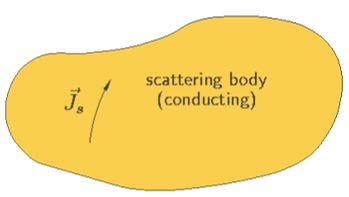Specifying the Relevant Integral Equation
Specify the integral equation by decomposing the fields into two parts.
Incident and Scattered Fields
Basic laws of physics dictate when an electromagnetic field encounters an object, currents are excited on the object. These currents will subsequently re-radiate. This behaviour is referred to as “electromagnetic scattering”.

Figure 1. An arbitrary shaped conducting body.
Finding the Incident Field
In RCS applications, the incident field is a plane wave. For example, a plane wave incident from the negative X axis with the electric field z-polarized gives the incident field as:
In antenna problems, the incident field, also denoted the “excitation,” is usually a voltage source. A simple form of excitation is the “delta-gap” feed. For an impressed voltage V at the terminals of an antenna over a gap of length δ the incident field can be written as:
If this feed is applied to a wire, the length of the gap is typically the length of a wire segment. Other types of incident fields are magnetic frills and elementary Hertzian dipoles.
Finding the Scattered Fields
To find the scattered fields an integral equation is applied to the surface currents. This is written in a simple notation as follows: where represents the integral operator and are the unknown currents to be found.